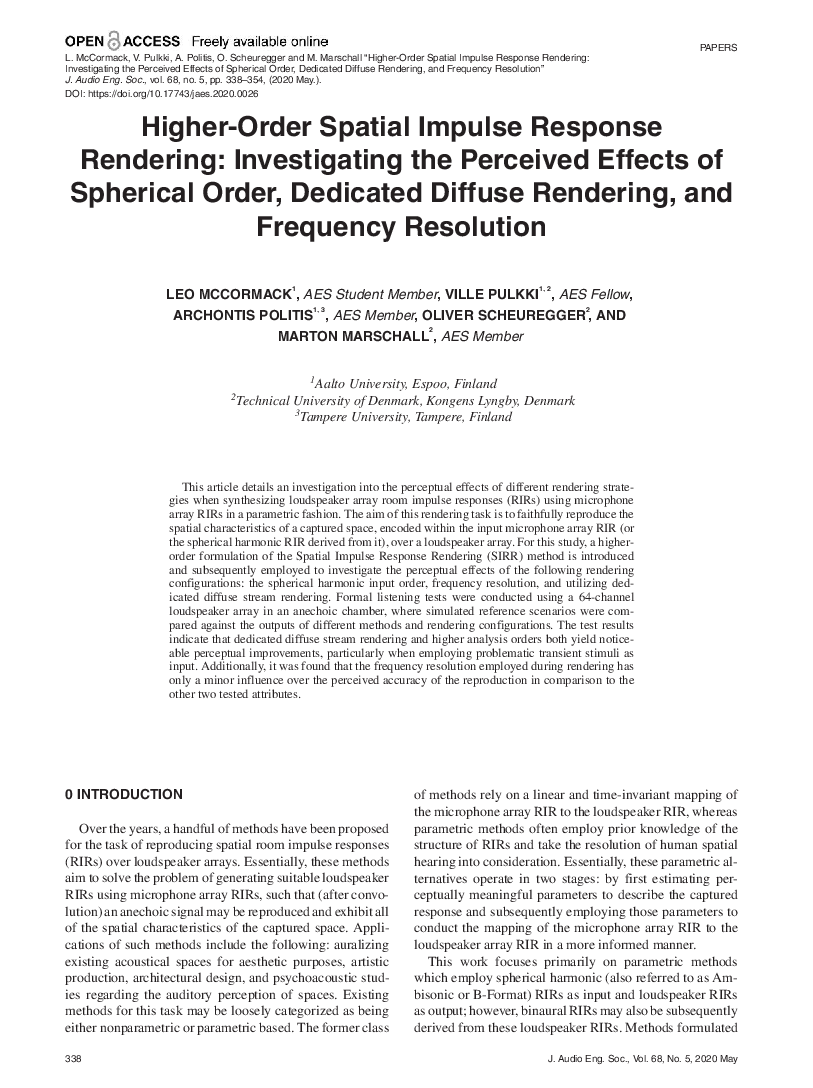Home / Publications / E-library page
You are currently logged in as an
Institutional Subscriber.
If you would like to logout,
please click on the button below.
Home / Publications / E-library page
Only AES members and Institutional Journal Subscribers can download
This article details an investigation into the perceptual effects of different rendering strategies when synthesizing loudspeaker array room impulse responses (RIRs) using microphone array RIRs in a parametric fashion. The aim of this rendering task is to faithfully reproduce the spatial characteristics of a captured space, encoded within the input microphone array RIR (or the spherical harmonic RIR derived from it), over a loudspeaker array. For this study, a higherorder formulation of the Spatial Impulse Response Rendering (SIRR) method is introduced and subsequently employed to investigate the perceptual effects of the following rendering configurations: the spherical harmonic input order, frequency resolution, and utilizing ded- icated diffuse stream rendering. Formal listening tests were conducted using a 64-channel loudspeaker array in an anechoic chamber, where simulated reference scenarios were compared against the outputs of different methods and rendering con- figurations. The test results indicate that dedicated diffuse stream rendering and higher analysis orders both yield noticeable perceptual improvements, particularly when employing problematic transient stimuli as input. Additionally, it was found that the frequency resolution employed during rendering has only a minor influence over the perceived accuracy of the reproduc- tion in comparison to the other two tested attributes.
Author (s): McCormack, Leo; Pulkki, Ville; Politis, Archontis; Scheuregger, Oliver; Marschall, Marton
Affiliation:
Aalto University, Espoo, Finland; Technical University of Denmark, Kongens Lyngby, Denmark; Tampere University, Tampere, Finland
(See document for exact affiliation information.)
Publication Date:
2020-05-06
Import into BibTeX
Permalink: https://aes2.org/publications/elibrary-page/?id=20852
(919KB)
Click to purchase paper as a non-member or login as an AES member. If your company or school subscribes to the E-Library then switch to the institutional version. If you are not an AES member Join the AES. If you need to check your member status, login to the Member Portal.

McCormack, Leo; Pulkki, Ville; Politis, Archontis; Scheuregger, Oliver; Marschall, Marton; 2020; Higher-Order Spatial Impulse Response Rendering: Investigating the Perceived Effects of Spherical Order, Dedicated Diffuse Rendering, and Frequency Resolution [PDF]; Aalto University, Espoo, Finland; Technical University of Denmark, Kongens Lyngby, Denmark; Tampere University, Tampere, Finland; Paper ; Available from: https://aes2.org/publications/elibrary-page/?id=20852
McCormack, Leo; Pulkki, Ville; Politis, Archontis; Scheuregger, Oliver; Marschall, Marton; Higher-Order Spatial Impulse Response Rendering: Investigating the Perceived Effects of Spherical Order, Dedicated Diffuse Rendering, and Frequency Resolution [PDF]; Aalto University, Espoo, Finland; Technical University of Denmark, Kongens Lyngby, Denmark; Tampere University, Tampere, Finland; Paper ; 2020 Available: https://aes2.org/publications/elibrary-page/?id=20852
@article{mccormack2020higher-order,
author={mccormack leo and pulkki ville and politis archontis and scheuregger oliver and marschall marton},
journal={journal of the audio engineering society},
title={higher-order spatial impulse response rendering: investigating the perceived effects of spherical order, dedicated diffuse rendering, and frequency resolution},
year={2020},
volume={68},
issue={5},
pages={338-354},
month={may},}
TY – paper
TI – Higher-Order Spatial Impulse Response Rendering: Investigating the Perceived Effects of Spherical Order, Dedicated Diffuse Rendering, and Frequency Resolution
SP – 338 EP – 354
AU – McCormack, Leo
AU – Pulkki, Ville
AU – Politis, Archontis
AU – Scheuregger, Oliver
AU – Marschall, Marton
PY – 2020
JO – Journal of the Audio Engineering Society
VO – 68
IS – 5
Y1 – May 2020